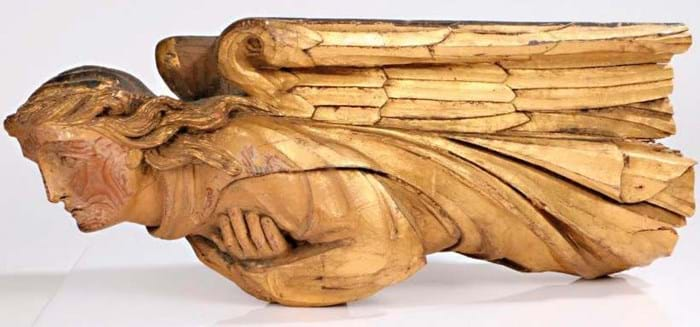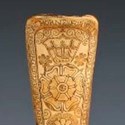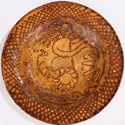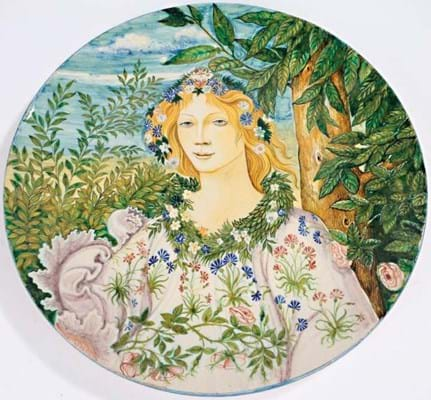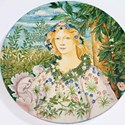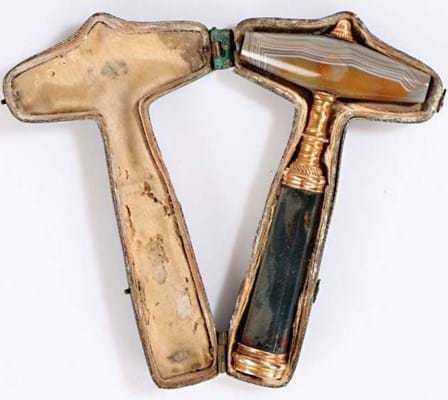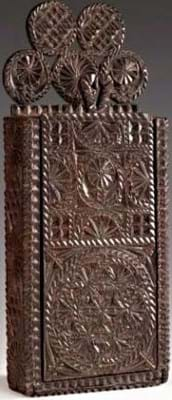While his name appears on almost 30 carved bovine horn objects from the late Elizabethan and Jacobean era, he is not mentioned in the rolls of the Worshipful Company of Horners, sparking the suggestion that his general stock in trade may have been quite different.
Wayne Robinson’s A Catalogue of Shoehorns made by Robert Mindum 1593-1613 is the best source of information on the subject. Given the similarities of the decoration to pamphlets and broadsides of the period, he speculates that Mindum may have been a printer used to working with woodblocks. He could have bought his shoehorns as ‘blanks’ and decorated them to order for a local audience.
A newly discovered James I shoehorn by Mindum dated 1613 sold to a collector for £7400 (estimate £2000-3000) at Bishop & Miller’s (22% buyer’s premium) first designated oak and country sale in Stowmarket, Suffolk, on October 14.
Recently found in an East Anglian home, it is the 27th Mindum shoehorn to be documented (two powder horns are also known). Carved with flowers and geometric design, the text to the edge reads Robert Mindum Made This Shooing Hoorne For William Wheatee Gentleman 1613.
A number of Mindum horns have appeared for sale in the 21st century: one dated 1597 (£3200 at Christie’s South Kensington in 2005), another dated 1598 ($17,000 at Sotheby’s New York in 2007) and a shoehorn with a Tudor Rose design made for a Mistress Blake in 1612 (£8800 at Rowley’s in Newmarket in 2010).
Most recently, in 2015 Matthew Barton offered another new discovery incised and inked with a lady, her hands on her hips, and the legend This is Robart Hendart Mindum 1596.
New auctions
Bishop & Miller is conducting these oak furniture and works of art sales with the input of former Bonhams specialist David Houlston. Follow-up events are planned for January, May and September 2022.
At this sale the more notable bids were taken for objects rather than furniture proper.
They included £3100 bid for a 13in (33cm) slipware dish decorated in dark slip against a light background with a mermaid within a wide hatched rim. This was in the manner of the Toft family working in Burslem in the second half of the 17th century (mermaids were a favourite Toft motif and one doubtless familiar from many Tudor and Stuart tavern signs), although this piece was more probably 18th or early 19th century. Nonetheless, estimated at £400-600, it took £3100.
A fine example of Renaissance style pottery was a 20in (50cm) Cantagalli polychrome maiolica charger decorated with a polychrome scene after Botticelli’s Primavera.
Boldly titled, signed by artist L Paoletti and dated 1882, it was made just a few years after Ulisse Cantagalli and his brother Roberto assumed control of the family works and began these historicist exercises in the 16th style. Similar pieces by Paoletti (with equally elaborate inscriptions verso) were shown at a number of international exhibitions including in Milan (1881), Turin (1884), Antwerp (1885) and Venice (1887). The South Kensington Museum (which acquired a Toft mermaid dish as an interesting example of folk pottery in 1869) bought Cantagalli pieces for its collection in 1888.
Oliver Miller of Bishop & Miller described this piece as a lucky survivor. “It came into us left in the bottom drawer of a chest of drawers the client had dropped in. They had no idea it was in the chest so had a very nice surprise.” Guided at £200-300, it took £4300 online from an Italian buyer, the latest in a series of strong prices for Cantagalli wares.
Always popular with fishing tackle collectors and as great decorative objects, an early 20th century carved and painted half block model of a salmon, 3ft 6in (1.05m) long, sold at £4000, while £2400 was bid for a finely carved and gilt roof angel of the type associated with East Anglian hammer beam church roofs. Most of these are synonymous with the pre- Reformation church but this 2ft 2in (65cm) example was thought to be late 17th century.
An early 18th century Welsh candle or tinder box worked with a series of chip and fan carved roundels to a sliding lid and with a heart-shard handle was a predictable favourite. Measuring 11in (28cm) high by 4½in (12cm) wide, it made £1600 as the choice piece in a consignment of treen.
A less vernacular craft and more deluxe object for the metropolitan elite, an 18th century agate and gold cage work travelling corkscrew, was a hugely expensive object when it was made in pre-revolutionary France.
It was of particular note for its two-tone hard stone (a green-brown handle and a variegated blue-grey shaft) together with its survival of its original shagreen case. Part of the estate of a former antiques dealer, this corkscrew found many admirers at its modest guide of £500-700 and sold at £3600.



